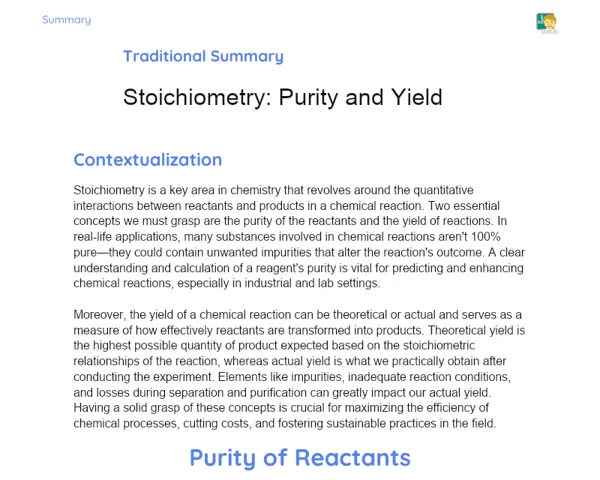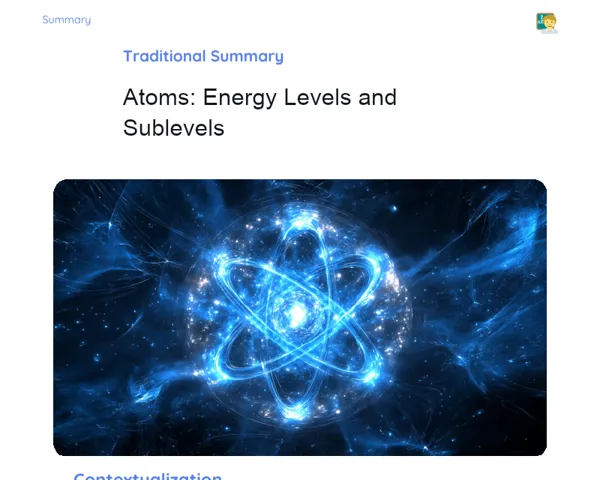Summary Tradisional | Equilibrium: Solubility Product
Contextualization
The solubility product, denoted as the equilibrium constant Ksp, is a critical concept in chemistry that deals with the solubility of sparingly soluble salts in aqueous solutions. This concept is determined by multiplying the molar concentrations of the ions in a saturated solution, each raised to its respective stoichiometric coefficient. Understanding Ksp is vital for interpreting the behaviour of saturated solutions and the process of precipitate formation, and it finds extensive applications in sectors such as industry, mining, and wastewater management.
A relatable example is the dissolving of table salt (NaCl) in a glass of water. When we add salt, it dissolves until it reaches the saturation level, at which point no more salt will dissolve, leading to a dynamic equilibrium between the dissolved ions and the undissolved solid. This equilibrium can be described using the solubility product constant. Additionally, the common ion effect, which refers to how the presence of an already existent ion in the solution decreases the solubility of a salt, plays a significant role in industrial applications and the buildup of deposits in plumbing systems.
To Remember!
Solubility Product Concept (Ksp)
The Solubility Product (Ksp) is an equilibrium constant for poorly soluble salts. To fully understand this concept, it's important to realize that in a saturated solution, there is a dynamic equilibrium between the dissolved salt and the undissolved solid. This equilibrium is expressed by the Ksp constant, which equals the product of the molar concentrations of the ions in the saturated solution, raised to their respective stoichiometric coefficients.
For instance, consider the salt AgCl (silver chloride). The dissolution can be represented as AgCl(s) ⇌ Ag⁺(aq) + Cl⁻(aq). The Ksp is calculated by multiplying the concentrations of the ions: Ksp = [Ag⁺][Cl⁻]. In a saturated solution, when the ions reach the concentration equal to Ksp, the system is in equilibrium, meaning any additional salt will not dissolve further.
Grasping the Solubility Product is essential for predicting whether a salt will form a precipitate in a specific solution. This has important real-world applications in areas like chemical purification, water treatment, and pharmaceuticals.
-
Ksp is an equilibrium constant for poorly soluble salts.
-
Represents the product of the molar concentrations of ions in a saturated solution.
-
Essential for predicting the precipitation of salts in solutions.
Calculating the Solubility Product
To calculate the Solubility Product (Ksp), it's necessary to know the concentrations of the ions in a saturated solution. The dissolution equation of the salt outlines the stoichiometric relationships between the ions and the dissolved salt. For example, with PbI₂, the dissolution equation is PbI₂(s) ⇌ Pb²⁺(aq) + 2I⁻(aq). In a saturated solution where the concentration of Pb²⁺ is 1.3 x 10⁻³ M, the concentration of I⁻ would be double, or 2.6 x 10⁻³ M.
To determine Ksp, we apply the expression Ksp = [Pb²⁺][I⁻]². Substituting in the concentration values, we find Ksp = (1.3 x 10⁻³)(2.6 x 10⁻³)², yielding a Ksp value of 8.8 x 10⁻⁹. This value represents the equilibrium ion concentration product in the saturated solution.
Calculating Ksp is crucial for addressing solubility issues and predicting precipitate formation, helping chemists determine the maximum solute amount that can dissolve before precipitation starts.
-
Ksp calculation involves the concentrations of ions in saturated solutions.
-
Uses the stoichiometric relationships from the salt's dissolution equation.
-
Essential for solving solubility issues and predicting precipitation.
Common Ion Effect
The common ion effect describes the reduction in the solubility of a salt when a common ion is already present in the solution. This can be explained through Le Chatelier's Principle, which tells us that an equilibrium system will shift to minimize the impact of any changes in the concentrations of the components involved.
For instance, when NaCl is added to a saturated solution of AgCl, the Cl⁻ ion concentration rises due to the dissociation of NaCl. This enhanced Cl⁻ concentration pushes the equilibrium of AgCl's solubility to the left, leading to more AgCl precipitating out of the solution. Essentially, the system compensates for the introduction of the common ion by lowering AgCl's solubility.
The common ion effect has significant implications in both industrial and laboratory settings, where controlling solubility is crucial. Understanding this effect is key for managing the solubility of compounds in various areas, such as substance purification and wastewater treatment.
-
The presence of a common ion reduces a salt's solubility.
-
Explained by Le Chatelier's Principle.
-
Key for controlling solubility in industrial and lab processes.
Practical Applications of the Solubility Product
The Solubility Product (Ksp) has diverse practical applications, both in industries and in daily life. In mining, for example, Ksp principles are employed to precipitate valuable metals from their aqueous solutions. By tweaking the ion concentrations, one can directly control the precipitation of specific metals, facilitating efficient extraction and purification.
In water treatment, it’s vital to manage the solubility of salts to avoid scale buildup in pipes and systems. Chemical engineers can leverage Ksp knowledge to adjust water conditions, minimizing unwanted salt precipitation and maintaining effective water distribution.
Additionally, in pharmaceuticals, controlling solubility is key for effective drug production. Solubility greatly impacts drug absorption and bioavailability. By manipulating Ksp, pharmaceutical chemists can enhance the solubility of compounds, thereby optimizing their therapeutic effectiveness.
-
Applied in mining to precipitate valuable metals.
-
Essential in water treatment to avoid scaling.
-
Crucial in pharmaceuticals to enhance drug solubility.
Key Terms
-
Solubility Product (Ksp): Equilibrium constant for describing the solubility of poorly soluble salts.
-
Saturated Solution: A solution that has reached its maximum solute capacity, achieving dynamic equilibrium.
-
Common Ion: An ion already present in a solution that decreases the solubility of a salt as described by Le Chatelier's Principle.
-
Le Chatelier's Principle: This principle states that a system at equilibrium will adjust to lessen the impact caused by changes in component concentrations.
-
Precipitation: The process of forming a solid from a solution when the solubility limits are surpassed.
Important Conclusions
The Solubility Product (Ksp) concept is an indispensable tool for comprehending the solubility of poorly soluble salts and anticipating precipitate formation in solutions. The Ksp constant offers critical insights into the dynamic equilibrium between dissolved solutes and undissolved solids in saturated solutions. Mastering this concept is vital for tackling solubility challenges and finds extensive applications in industry, mining, and water treatment.
Moreover, the common ion effect illustrates a significant application of Ksp. It reveals how the presence of an ion already in solution can diminish a salt's solubility, a phenomenon underpinned by Le Chatelier's Principle. This understanding aids in managing the solubility of compounds across diverse processes in industries, laboratories, and wastewater treatment.
The practical applications of the Solubility Product are far-reaching; they include precipitating valuable metals in mining, preventing scaling in water systems, and improving drug solubility in pharmaceuticals. These applications emphasize the importance of mastering and manipulating compound solubility to enhance processes and products across various technological and industrial landscapes.
Study Tips
-
Revise the practical examples discussed in class and practice additional problems related to Ksp calculation and the common ion effect.
-
Familiarize yourself with Le Chatelier's Principle and its application across different chemical equilibrium systems to deepen your understanding of its impact on solubility.
-
Investigate the real-world applications of the Solubility Product in different domains, such as mining, water treatment, and pharma, to observe how theory translates into practice.



